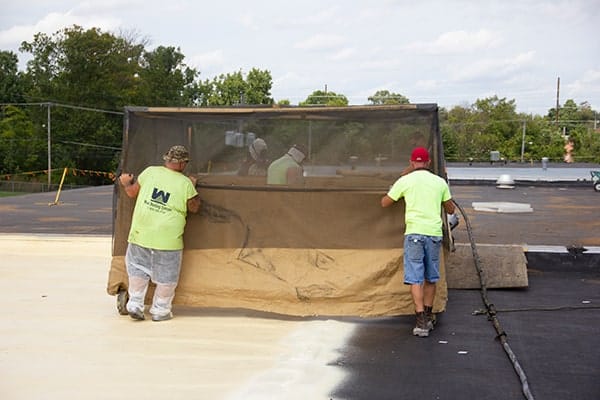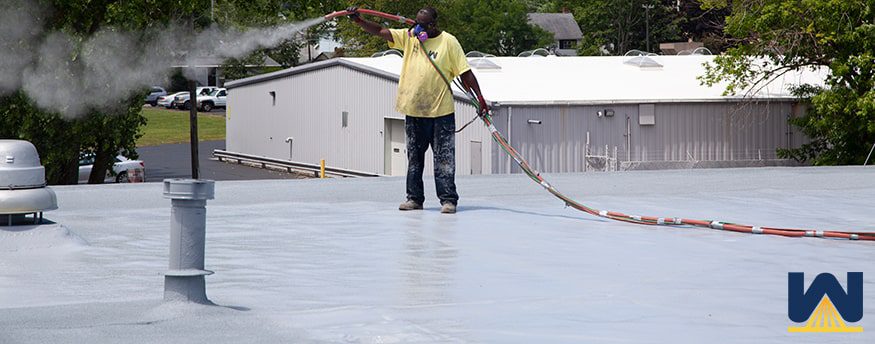The short answer is that it depends. It depends on many factors, such as:
- How much foam is going to be installed (1″ vs. 2″)
- What percentage of the roof has wet insulation (0%, 20%?)
- How long of a warranty is desired (10 years, 20 years?)
- How cooperative is the weather? (lots of rain days, days of high winds)
We randomly looked at 10 spray foam roofing jobs. The average amount of spray foam installed daily was around 1940 sq. ft.

However, there are two outliers, Client 7 (too much foam installed) and Client 3 (not enough foam installed).
When you remove these outliers, the average spray foam installed daily is 1585 sq. ft.

If you take the square footage of your roof, then divide it by 1585, you’ll know approximately how many days it’ll take to install your roof.
For example, on a 20,000 sq. ft. roof, it would take approximately 12.5 days to complete the project (20,000/1585).
You might have some other questions about the speed of a spray foam installation, such as:
- How fast can a spray foam roof be installed vs. other roofing systems?
- How fast can a spray foam roof be installed in perfect conditions?
- How long will I have to wait before a roofing contractor comes out?
- What characteristics of a roof slow down the installation process?
Let’s get started!
How fast can a spray foam roof be installed vs other roofing systems?
On a 20,000 sq. ft. roof, a spray foam roof will take about 12 days to install.
For the same roof, a single-ply or metal roof will take about 20 or more days to install.
Why?
A spray foam roof is spray-applied.
Here is a video showing how a spray foam roof is installed from start to finish:
That means that spray foam can go around penetrations easier than the other two systems. Also, when spray foam is sprayed, it doesn’t need attention at the seams or perimeters like the other two systems need.
NOTE: Single-ply roofers will argue that they can install large sheets, such as ones that are 10×100 feet in size. This is true, but once you add in the time to heat or fasten the seams together, get watertight around penetrations, and become watertight around the roof’s perimeter, a spray foam roof gets applied much faster.
How fast can spray foam be installed in perfect conditions?
If the roof is prepared and it’s a perfect weather day, a spray foam roofing contractor can spray 8,000-10,000 sq. ft. of foam daily.
For the roof to be prepared for spray foam installation, all the saturated areas must be removed and replaced with similar material. This process is started with an infrared inspection.
The next step is to make sure the roof is clean and dry. This is done with power washing. Once safety protocols are in order (HVAC units are turned off and covered, fall protection areas are identified, etc.), a spray foam contractor can pull up the hose and begin spraying.
Perfect weather for a spray foam installation includes:
- The temperature is at least 50 degrees. Spray foam will not react, adhere, or perform as it was designed to if installed at a sub-50-degree temperature.
- There’s a dry forecast for consecutive days. No roofing system can be installed when it rains; spray foam is no different. When it rains every other day, it can extend a roofing project because each day begins with ensuring the roof is dry from yesterday’s rain.
- There’s little to no wind. Spray foam is very light, so the wind can take it and carry it to other areas, such as cars, windows, balconies, etc. If there are high winds, a windscreen or spray booth will be used, which can slow production.

How long will I have to wait before a roofing contractor comes out?
If you fill out a request for a quote form or call a roofing contractor, chances are they will be able to come onto your roof in the next few days.
They will inspect the roof, see where the problem areas are, take photos, pull core samples, and much more.
With this information, they can give you a scope of work, price, and an estimation of when the actual work can be done.
If you request a quote during the Spring, when it’s not full-throttle roofing season, you will be at the front of the list to get your roof done. This can be as soon as a few days.
It could take a few months to get the work done if you request a quote mid-Summer.
Throughout the year, roofing contractors build a backlog that gets longer and longer until the end of Summer.
NOTE: Some good advice would be to call a roofing contractor early in the year. There’s the advantage of choosing which days/week you’d prefer to have your roof done, but also you take advantage of supply and demand. Later in the Summer, when there’s a long backlog, roofing contractors raise the price because they can afford to with so many building owners requesting roofs at the last minute before Fall/Winter.
What characteristics of a roof slow down the installation process?
Some roofs are easier to install than others. Here’s a list of variables that increase or decrease the time it’ll take to install your roof:
- The amount of tear-off required
- The number of penetrations
- How difficult is it to get on your roof
The amount of tear-off required
Before a roofing project can begin, an infrared inspection is needed to determine how much water is saturated in your insulation.
If there’s more than 25% saturation, it’s best to tear the entire roof off and start over.
If there’s less than 25% saturation, it’s cost-effective to remove those areas, install similar materials to the ones you’re removing, and then treat the entire roof with a new roofing system.
It’s no surprise that the more tear-off required, the more time it will take to complete your roofing project.
The number of penetrations
A penetration is anything that comes up through the roof. The most common penetrations are:
- HVAC units
- Pipes
- Drains
- Exhausts
- Skylights
If you’re installing a new single-ply roofing system, these greatly slow the installation time of your project. Each penetration will need to have a boot installed around it or be custom-cut in some way to create a watertight environment.
Think of a single-ply roof that comes in a 10×10 square. These are easily installed until there’s a pipe in the middle that will need special attention to make the area watertight.
This is one advantage of a spray foam roofing system.
Since spray foam is spray applied, it’s easy to spray around penetrations and encapsulate the area, making it watertight.
Take a look at this video to see how easy spray foam can encapsulate a penetration:
NOTE: For a single-ply system, it’ll take around 30 minutes to roof around a penetration. For spray foam, it will take about two minutes.
How difficult is it to get on your roof?
How accessible your roof is will play a large part in how fast the roofing project can be completed.
If your building is in a downtown area, where it’s difficult to park large trucks near your facility, this will slow down production.
A building with multiple roofs of different heights (think of a school or hospital) will cause a roofing project to take longer than a standard flat roof.
Is a ladder the only way to get on your roof? If so, bringing up materials can be more difficult than a roof with stairs.
This isn’t a huge issue, but something that gets considered in the overall price of a roofing project.
Time is money and roofing installations are no different
On average, a spray foam roof is installed 50% faster than any other roofing system.
- 10 days vs. 20 days
- 5 days vs. 10 days
These are valuable days in which there are no roofers on site, no one shutting down your HVAC units, no one taking up your parking spaces, etc.
The faster you can check a task off your list, the better.
West Roofing Systems has been around since 1979. One of the best points we can give a building owner is that a spray foam roof can be installed quickly, with fewer guys, and that your money is going into the science of the roofing system, not on an extensive labor force.
Now you know about the installation times of popular roofing systems, and the variables that can increase or decrease how long it will take to complete your roofing project.
Since we know spray foam can be installed fast, how about other common questions, such as:
And if you want to compare spray foam to metal, single-ply, and coating systems, download the eBook below.


